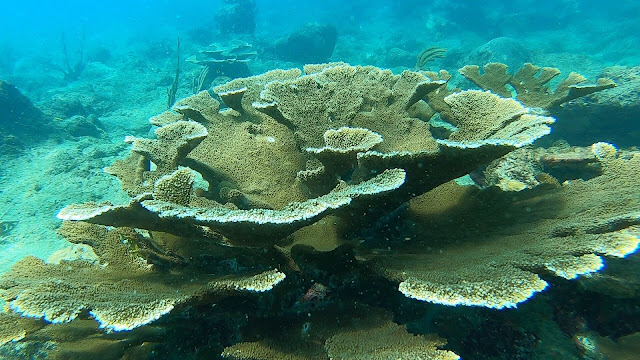Where does your Wastewater go?
Dr Anjani Ganase reminds us that what
drains from our islands ends up in the sea. How do we ensure that we do not
enrich the coastal waters with chemicals and pollutants from agriculture,
manufacturing and yes, household use.
All drains lead to the ocean, but do we think about this when we wash our cars, do our laundry, clean our dishes? Nutrient pollution is caused by the nitrates and phosphate compounds that flush into rivers and coastal marine environment from the use of agricultural fertilisers, discharge of high volumes of greywater, and industrial effluent. Nutrient pollution is a growing issue impacting our waterways and the ocean with unforeseen consequences. At the global scale it is rapidly becoming a major concern given the many other large-scale issues that are plaguing regions of the world. Most noticeably, in the Caribbean we see the rise of sargassum blooms in the southern Atlantic, the presence of harmful algal blooms in the northern Caribbean and the expansion of dead or hypoxic zones that are uninhabitable.

The upper reaches of Rio Seco are still
pristine. It joins the Salybia river which enters the sea at Toco. Photo by
Anjani Ganase
Start in the home
While the lack of regulation in the use of fertilisers in agriculture and industrial effluent are major issues, what is often overlooked are the domestic discharges of large volumes of nutrient rich grey water from households directly into our country’s freshwater systems. Grey water is any type of water that is discharged from a household other than sewage (aka black water). It is made up of a relatively high volume of water contaminated with nutrients along with other physical, chemical and even biological pollutants. The average Trinidadian household uses and therefore disposes of up to 82 gallons of water per day from cleaning, dishwashing, laundry, showers, cleaning the car and the yard. The used grey water is disposed directly into the surroundings via the street drains which then run into our rivers and streams that flow to the ocean. Making up chemical pollutants and nutrients, here are some of what goes out in wastewater: nitrates, phosphates, ammonia compounds, other synthetic organic compounds used for cleaning, physical contaminants of plastics, cloth fibres, particulates, food scraps, grease and other organic matters. Biological contaminants include bacteria and protozoa, some of which are pathogenic like E. coli and salmonella.
If a single household uses up to 82 gallons a day and most is discharged as greywater, let’s imagine the discharge quantities of say the Diego Martin Borough or the communities that surround the Maraval River or south-west Tobago. This results in highly polluted discharges, yet it is the norm in many places for household drains to pipe directly into storm drains and rivers.
What does this do to the river ecosystems?
The discharge of greywater into rivers damages river ecosystems through resulting algal blooms or eutrophication. High organic matter breakdown can cause microbial blooms and oxygen deficient zones which result in die off of freshwater and nearshore marine life. Plastics, rubber and other synthetic materials are toxic to aquatic animals, and sediment runoff smothers river and lake benthos. Considering that Maraval, Diego Martin, and St Ann’s rivers are all concrete drains, we have systematically destroyed these river ecosystems, which are the very systems needed to dampen the nutrient pollution flowing to the sea. The same happens in south-west Tobago and Scarborough where there is a high concentration of household and industrial development along with businesses and high corresponding discharge out to sea. The coral reefs along the south and south-west coasts are overgrown by macroalgae that smother corals and prevent coral recruitment and growth. In a vicious cycle, macroalgae also releases chemicals that are also harmful to coral health.
Managing grey water discharge
Especially on islands, the negative impacts of household discharges are far reaching with consequences to human health and wellbeing. However there are many strategies to managing greywater discharge that can be incorporated into your home or through your community for larger scale treatment.
Grey-water treatment can be done in similar manner to sewage water through a series of steps including filtration, biological and chemical treatment before discharge. Other methods include a constructed wetland with the biota and environment introduced to naturally remove the pollutants and serve as a buffer before discharging to downstream and connected waterways or for downstream use such as irrigation of agricultural lands or gardens, especially in drought prone areas. Scientific studies have shown how this treatment process for agricultural purposes abides by health and safety standards. Some agencies have even suggested full recycling of water for potable use, however, regardless of the method, trust in the organisation and the process is essential to get buy in for water recycling.
For smaller scales, homes with gardens or green spaces can also be set up to naturally filter greywater from the drains for use in the garden. Treating your waste water starts with being more selective and purchasing eco-friendly cleaning products that are not as destructive as chemical waste. Natural products are also cheaper and accessible, such as baking soda, vinegar and castile (plant based) soaps. On the other hand, bleach and other chemicals are difficult to treat at home and degrade soil quality as they are toxic for your garden. Consider creating a natural filtration system that separates the solid parts of the water to be composted and then the treatment of the organic matter in the water is passed through gravel and sand percolating to facilitate natural breakdown of the heavy nutrients and avoid a build-up of nasty microbes. A grease trap can collect all the oils and fats from the kitchen, which can then be used to fertilise trees or composted. Selection of wet or water plants growing near the water collection areas contribute to the natural filtration system. The plant roots stabilise the filter and create a network trapping matter while sucking up nutrients for themselves.
For community areas or housing developments, management of grey water should also be included as a CEC requirement in addition to waste water management from the compound, possibly to facilitate water for gardens and treatment before discharge. Ecosystem based management includes the formation of green walls and living facades for grey water filtration.
Just as important as the responsibility for what comes into your space is the responsibility for what leaves it. Not only solid waste, we need to be mindful of what goes out in waste water.

Sargassum along Tobago’s Caribbean coast. Photo
by Anjani Ganase
References
Oteng-Peprah, Michael, Mike Agbesi Acheampong, and Nanne K. DeVries. "Greywater characteristics, treatment systems, reuse strategies and user perception—a review." Water, Air, & Soil Pollution 229.8 (2018): 255.
Gholami, Moeen, Aisling D. O'Sullivan, and Hamish R. Mackey. "Nutrient treatment of greywater in green wall systems: A critical review of removal mechanisms, performance efficiencies and system design parameters." Journal of Environmental Management 345 (2023): 118917.
Hamidi, Muhammed Nimet. "Greywater reuse for irrigation: A critical review of suitability, treatment, and risks." Science of The Total Environment 975 (2025): 179272.



Comments
Post a Comment